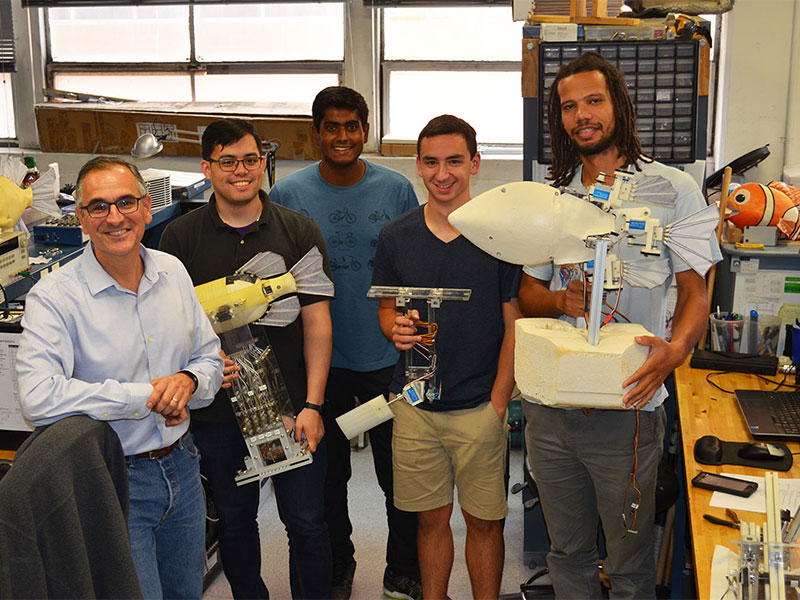How do you design an underwater vehicle that maneuvers agilely through oceans and across rivers? You could start by looking at hundreds of years of naval history, comparing the first prototype submarine in the 16th century to the Deepsea Challenger, which James Cameron piloted to the deepest known point on Earth in 2012.

Professor James Tangorra (left) with students in his lab.
Or you could look at aquatic mammals.
In a way, the latter approach is what James Tangorra, PhD, professor of Mechanical Engineering and Mechanics, does every day. His research focuses on the bio-inspired design of aquatic robotics. Studying how marine animals move and how their intertwined muscular, skeletal, and nervous systems interact, Tangorra and his team at the Laboratory for Biological Systems Analysis hope to develop underwater vehicles that move with animal-like agility across many terrains.
“As engineers, when we are presented with a problem, we tend to hone in on a few different solutions,” Tangorra says. “But there are tens of thousands of species of fish and aquatic mammals, and among those, they have a lot of things in common, but there are also some interesting variances when the conditions for survival change, like needing to live in deep water or within the currents that exist near shore. So we look at those variances and see how it can inspire our imagination.”
Tangorra’s work in the area has received regular funding from government sources. The latest grant, a three-year, $1.5 million grant from the Office of Naval Research, is centered around studying sea lions. The grant is run by Dr. Megan Leftwich of George Washington University, and includes as co-Pis Harry Kwatny, PhD, S. Herbert Raynes Professor of Mechanical Engineering and Mechanics, and Frank Fish, PhD, Professor of Biology at West Chester University. Graduate research assistants Shraman Kadapa, Andy Drago, Nick Marcouiller are all working one the project as the basis of their PhDs.
“Sea lions are remarkably adept at moving across various conditions, from open ocean to rock and sand,” Tangorra says. “We are collaborating with biologists to figure out how that might work, and we develop hypotheses, create and test engineered models based on those hypotheses, and see what we learn. This goes back and forth between creating test equipment and then using that test equipment to evaluate the biological hypothesis in the research environment.”
Tangorra’s connection to the DoD extends beyond his time as a researcher. While serving with the Navy, one of his tours was to teach in Weapons and Systems at the U.S. Naval Academy.
“Sea lions are remarkably adept at moving across various conditions, from open ocean to rock and sand. We are collaborating with biologists to figure out how that might work.”
James Tangorra
“I had students who wanted to develop a robotic arm,” he explains. “I didn't know a ton about biology. So I went back to school for biology at Anne Arundel Community College. Once I decided to get out of the Navy and go into biomedical work, I ended up at MIT in a bioinstrumentation lab. And then we got a grant and we had to build a robot. And then all of a sudden I'm building robots to understand fish.”
While aquatic animals are certainly a great source of inspiration, Tangorra notes that his work is more nuanced than building a machine that acts exactly like a fish.
“When we do our job well, it can look like mimicry,” he says. “But we’re not trying to do exactly what the animal does. We’re trying to understand the underlying phenomena behind how they do what they do and find design inspiration in that.”